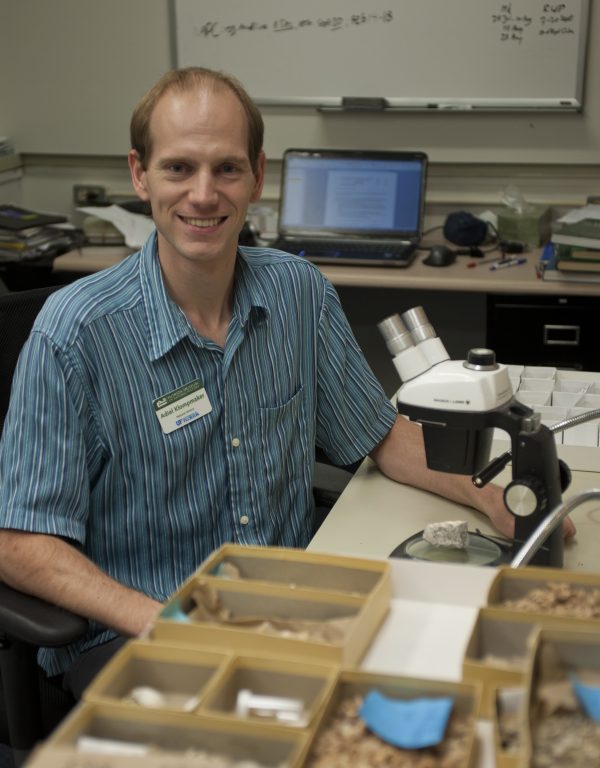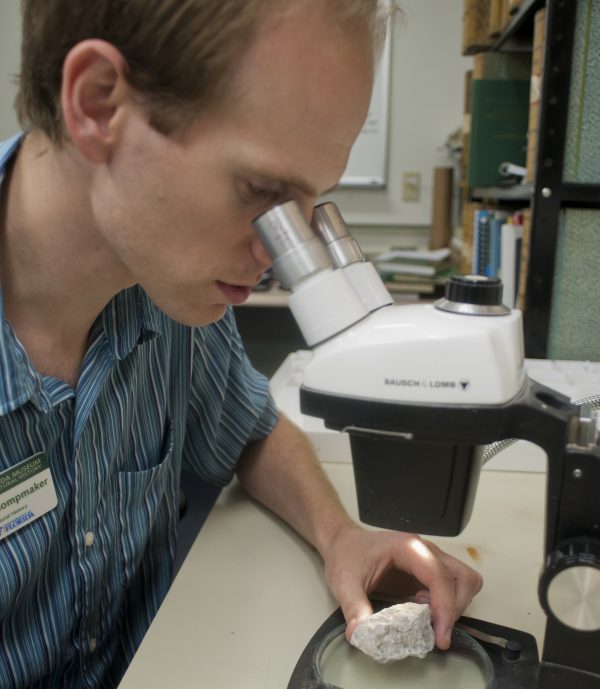
Florida Museum photo by Jeff Gage
Nearly 150 million years ago, many ancient crustaceans went extinct following a massive collapse of reefs across the planet, and new Florida Museum of Natural History research suggests modern species living in rapidly declining reef habitats may now be at risk.
Available online and scheduled to appear in the November 2013 issue of Geology, the study shows a direct correlation between the amount of prehistoric reefs and the number of decapod crustaceans, a group that includes shrimp, crab and lobster. The decline of modern reefs due to natural and human-influenced changes also could be detrimental, causing a probable decrease in the biodiversity of crustaceans, which serve as a vital food source for humans and marine animals such as fish, said lead author Adiël Klompmaker, a postdoctoral researcher at the museum on the University of Florida campus who started the study at Kent State University.
“We estimate that earth’s decapod crustacean species biodiversity plummeted by more than 50 percent during a sharp decline of reefs, which was marked by the extinction of 80 percent of crabs,” Klompmaker said. “If reefs continue to decline at the current rate during this century, then a few thousand species of decapods are in real danger. They may adapt to a new environment without reefs, migrate to entirely new environments or, more likely, go extinct.”

Florida Museum photo by Jeff Gage
Some scientists predict as much as 20 percent of the world’s reefs may collapse within 40 years, with a much higher percentage affected by the end of the century due to natural and human-influenced changes such as ocean acidification, diseases and coral bleaching.
The study is the first comprehensive examination of the rise of decapod crustaceans in the fossil record. Researchers created a database of fossils from the Mesozoic Era, 252 million to 66 million years ago, from literature records based on museum specimens worldwide. The data included 110 families, 378 genera and 1,298 species. Of the many important purposes museum collections serve, one of the most significant is helping scientists better understand where species occur and how those environments change over time. In this case, researchers examined the patterns of diversity and found an increase in the number of decapod species was influenced by the abundance of reefs, largely due to the role of reefs as a provider of shelter and foraging. Researchers call this period the “Mesozoic decapod revolution” because of the 300-fold increase in species diversity compared with the previous period and the appearance and rapid evolution of crabs.
Compiling information about crustaceans on this scale has historically been a challenge for researchers because most decapods possess a fragile and weakly calcified exoskeleton that does not fossilize well.
“Only a scant fraction of decapod crustaceans is preserved in rocks, so their fossil record is limited,” said study co-author Michal Kowalewski, curator of invertebrate paleontology at the Florida Museum. “But, thanks to efforts of paleontologists many of those rare fossils have been documented all around the world, finally giving us a chance to look at their evolutionary history in a more rigorous, quantitative way.”
“This new work builds a good case for the role of reefs in promoting the evolutionary diversification of crustaceans,” said David Jablonski, a paleontologist in the department of geophysical sciences at the University of Chicago who was not involved in the study. “We have to take their argument for the flipside of that story very seriously. The positive relation between reefs and crustaceans implies that the damage caused to reefs by human activities—from overfishing to ocean acidification—is likely to have cascading consequences for associated groups, including crustaceans.”
Jablonski said the study could serve as an important springboard for future research.
“It would be very interesting to extend this analysis into the Cenozoic Era, the 65 million years leading up to the present day,” Jablonski said. “And it would be valuable to look at the spatial structure of the crustacean diversification, for example how closely their diversification was tied to the extensive reefs in the western Pacific and was damped in the eastern Pacific with their much sparser contingent of reefs.”
Klompmaker, who recently visited a partially dead reef off the coast of Puerto Rico, said researchers are hopeful their study can contribute to future policy debates about the importance of reef protection and conservation in the western Pacific, the Caribbean and other regions in the world.
“I knew reefs weren’t doing well,” Klompmaker said. “I’d read about it and I’d seen it in photos, but to see it with my own eyes was to realize that it is very real.”
Study co-authors include Carrie E. Schweitzer with Kent State University at Stark and Rodney M. Feldmann with Kent State University.
Learn more about the Invertebrate Paleontology at the Florida Museum.